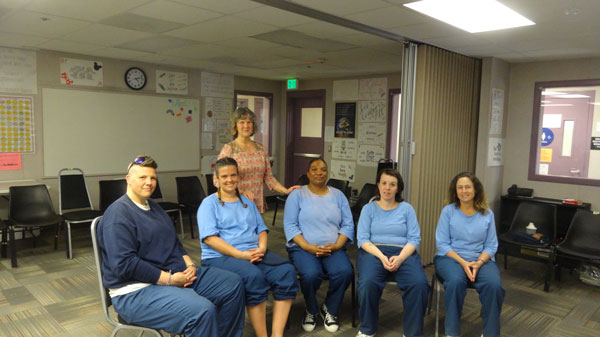Real Rehabilitation: Women Inmates Learn Transcendental Meditation

With about 220,000 women in the correctional system, the United States is one of the top incarcerators of women in the world. According to the American Civil Liberties Union, “Only five percent of the world’s female population lives in the U.S., yet nearly one-third of all the female prisoners in the entire world are here in the United States.”
Most incarcerated women have a history of substance addiction, domestic abuse, PTSD, mental illness, sexual abuse, addiction, or homelessness. Often their unfortunate history has led to the behavior that led to their incarceration. Many are deeply remorseful, ashamed and depressed—they know that it’s directly due to their own bad decisions that they are separated from their children and families.
In theory and practice, imprisonment as a form of punishment can deter a person from repeating harmful behavior in the future, but the most profound purpose of rehabilitation is to enable someone to move forward along a new, healthier path. Are programs that deeply transform women—increasing their intelligence, creativity, moral judgement, and harmonious behavior while reducing PTSD, cravings for drugs, anxiety and stress—available in jails and prisons today? According to some officials and inmates alike, there is at least one evidence-based program that can significantly decrease the factors that underly a woman’s self-defeating behavior—with the potential to rehabilitate the justice system itself:
How inmates at FWF learned to meditate
Nancy Bellmer has been a Transcendental Meditation teacher since 1974. About two years ago in California she taught a woman named Dawn Davison to meditate; Dawn was a retired women’s prison warden. Dawn took the TM course motivated by a desire to improve her own life, but upon experiencing the effectiveness and simplicity of the TM technique she was inspired to help make this program available to women inmates as quickly as she could. With more than 400 peer-reviewed studies on TM to back her up, she hoped it wouldn’t be a hard sell to correctional system authorities.
It actually took a year of seeking cooperation and permission from the authorities before Dawn’s inspiration became a reality—in a pilot program in Folsom Women’s Facility (FWF), funded by the California Department of Corrections and Rehabilitation. FWF opened in January of 2013 as a standalone section for women and houses about 400.
Originally 19 women at FWF attended the TM introductory presentation that explains the technique and its benefits. Although most were interested in learning right away, only six could be selected to learn the TM technique in this pilot program. The last part of the selection was random but the requirement for the first part was that they’d be incarcerated there for at least the next six months as the program involved a four-month study and follow-up. Also, participants needed to have a schedule that allowed for the time required to learn TM as well as for their meditations twice daily.
Initial Experiences
Nancy was impressed with the immediacy and clarity of the inmates’ profound and transformative results during their course of instruction in the TM technique. Every participant had immediate experiences of deep rest, inner peace and silence. During the course, they all noticed that they were feeling happier. One woman said she felt as if she was practically skipping through the halls, chasing butterflies—feeling carefree.
Some of the women remarked that though they might have felt isolated before learning Transcendental Meditation, they became less annoyed by chaotic behavior around them and began feeling more sociable and outgoing. “More tolerance” was a term many of them used a lot, and “more self-confidence.”
During her first week of TM, an inmate whose initials are L.B. who is taking classes to advance her education noted “In TM, I experience a deep relaxation I have never known. During the day, I feel joyful, more peaceful—want to smile so deeply. I didn’t feel a need to isolate. Less chaos inside. Noticed minimized anxiety…. Frozen TMJ bones and muscles softened within 48 hours of learning to meditate.” In the following week, she reported, “Great inner ease. I just smile for no reason. Less stress prior to midterms, better memory, studied with ease. Interactions with people around me and phone calls home seem more relaxed. One person commented that I don’t get caught up in the drama, and that my face has changed.”
M.H. commented during her first week of the TM practice: “Well-rested, relaxed and calm, less stress, no anxiety. Friendlier. Easy-going, less judgmental. Others say I’m more relaxed. Grateful to be in TM program.”
One of the older inmates, whose initials are S.K., reported feeling peaceful, calm, and free of physical pain and tension. She was able to stand upright for the first time in a long time and walk without the use of her cane as well as sleep without discomfort on the first day of meditating.
B.M. told Nancy that she was “Happier, more relaxed and tolerant. Grateful to be a part of this experience. Friendlier, energetic without caffeine!”
Within a month
Though most of the inmates have PTSD, the TM course participants noticed decreased depression and symptoms of trauma. “We found that there was a 65 % decrease in depression and trauma symptoms at one month. One inmate commented that she had so much more patience with things that happen around her over which she had no control and that it helped her stay calm despite her PTSD,” Nancy said. “In so many researched programs, including with inmates, active duty responders, veterans and victims of abuse, the TM technique has been shown by peer reviewed studies to reduce PTSD.”
M.H. told Nancy, “TM has improved my anxiety levels from a 10 all the way down to a 2. My brain feels less foggy- memory better.”
L.B. was now reporting that she was experiencing “A sort of ‘time-release of peace’ that just shows up throughout the day, especially when I need it. Not falling asleep at the computer during CAD class…. Short-term memory has increased. 85% healing of TMJ (frozen jaws). Quick recovery from intense stressful moments, feeling centered rather than a herd of horses running over me…. TM is the best thing that has come my way for healing!”
Substance abuse

Many women are incarcerated because of drug offenses. Nancy told me that at least half the women in this pilot program had abused drugs and were incarcerated for related reasons. Nobody plans to be a drug addict, but whether a woman needs something to be calmer, or more vital and dynamic, or to dig her way out of a black hole of misery, depression or anxiety, she may seek a quick fix through any choice in a wide range of illegally obtained drugs. Substance abuse can be mistakenly viewed by the user as self-medication, but unfortunately it gives rise to increased imbalance and dysfunction in her life in the longer term.
The TM technique reduce the causes of substance abuse and addiction. Due to the deep rest, improvements in brain function, and biochemical normalization that take place during the TM practice, it holistically nourishes all health and behavior. Although the TM program isn’t in itself a drug rehabilitation program, it enhances self-development which in turn results in a decrease of psychological and physiological problems, including those that lead to drug abuse.
A 1994 study published in Alcoholism Treatment Quarterlyshowed that the average impact of TM practice on reducing drug abuse was almost twice as large as the impact of peer influence and six times as large as the effect of all other methods investigated. At the same time, the data inciated that, along with relief from distress, there were long-term improvements in well-being, self-esteem and empowerment. In an earlier study published in Zeitschrift fur Klinische Psychologie, there was a precipitous decline in the percentage of subjects using opiates along with positive changes in psychological health once they learned the TM technique.
Research studies on TM, incarceration and rehabilitation
Previous programs offering the TM program have been in correctional settings including San Quentin, La Tuna, Stillwater, Lompoc, Walpole, Vermont, and Oregon State.
Since 1971 there have been 39 studies in correctional settings, including research published in Journal of Criminal Justice, International Journal of Comparative and Applied Criminal Justice, Criminal Justice and Behaviorand a Special issue of Journal of Offender Rehabilitation.
Among other findings, researchers have reported significant reductionsin inmate:
- Rule infractions
- Drug use
- Anxiety
- Aggression/hostility
- Depression
- Psychopathy
- Recidivism
- Obsessive-compulsive behavior
- Neuroticism
- Trauma
Researchers have found significantincreasesin inmate:
- Positive use of educational facilities
- Optimism
- Emotional stability
- Interest in real self-improvement
- Maturity
- Stability
Conclusions
Families suffer the penalty along with the women inmates, many of whom are single mothers. Nancy recommends that TM be offered to the prisoners’ families to relieve the emotional turmoil, stress and imbalances they suffer due to their family member’s incarceration. “The participating inmates who have families have all called or written to their families and encouraged them to learn TM. They tell them it’s the most beneficial program they’ve had in prison. One woman’s father who visited her at the prison commented that she seemed so much less stressed.”
Nancy told us that one participating inmate had great relief from pain and insomnia that were caused by a prior accident and by abuse. “There is such a broad range of benefits, and each woman had something unique that she found with TM as well as benefits they all had in common. I hope to expand the program with the state’s support. The inmates who heard the initial presentation but were not selected for this course have all expressed strong interest in being selected for future courses. They’ve noticed and commented on the positive effects in their peers who did get to learn TM.”
By the time the women in Folsom had been meditating for six weeks, they were all feeling transformed for the better. M.H. wrote: “I have nothing but good things to say about this program…. I’m more outgoing and very happy and want to live life like never before. Thank you for changing my life.”
L.B. said she was changing back to the younger relaxed woman that she could only now remember having been, and “feeling extreme gratitude to all who made this possible.”
A program that can restore a better, healthier, more harmonious quality of life for women will have a direct positive impact on their families and their community. There was a consensus among the participants that all inmates should have the opportunity to learn the Transcendental Meditation technique.
V.H. commented, “Thank you. This technique has improved a lot for me and I feel that others would benefit too, so I would like to see this be made available to others here.”
We agree.
About the Author
Janet Hoffman is the executive director of TM for Women Professionals, a division of TM for Women in the USA





